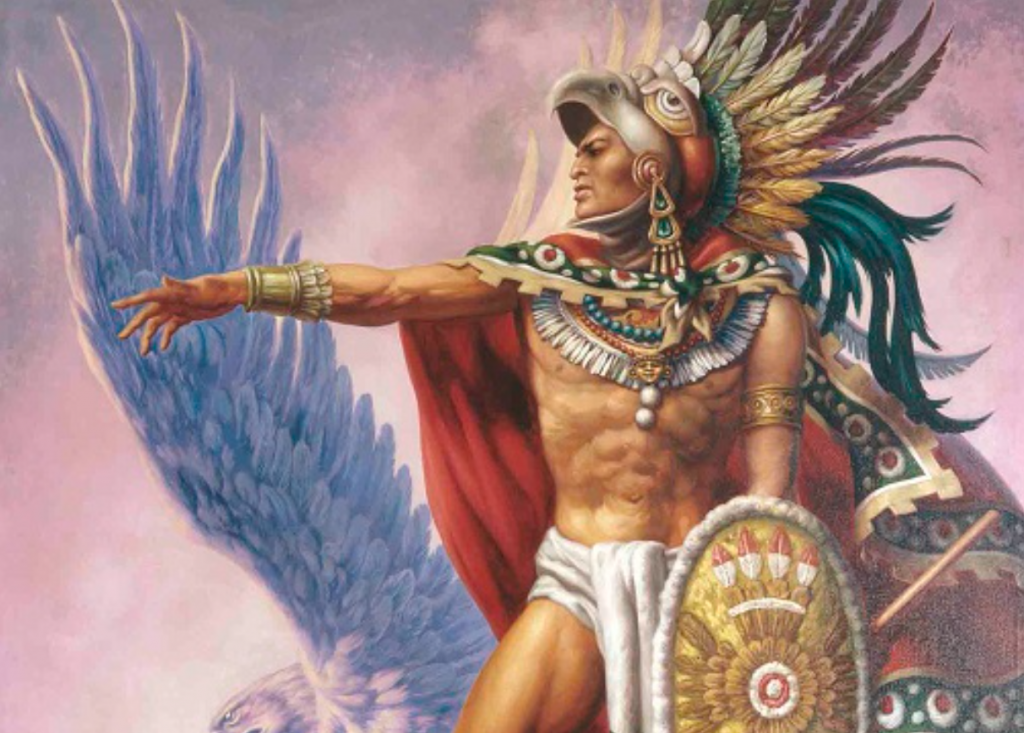Cuauhtémoc, although murdered in defeat, left a legacy as the last Aztec emperor who led Tenochtitlan in defense against Hernán Cortés and the Spanish invaders. The young warrior was initially selected to serve as emperor because of his fierce opposition to the Spanish invasion, which greatly appealed to the majority of the empire. Moctezuma II, who reigned during the first invasions of the Spanish, lost the support of his people, whereupon they publicly executed him for submitting and complying with the Spaniards.1 Moctezuma’s successor, Cuitlahuac, attempted a united resistance against the colonizers, but proved unsuccessful following his unexpected smallpox-related death only eighty days after beginning his reign.2 The last and final tlatoani, or emperor, was the young and vigorous Cuauhtémoc, whose assumption of power was supported by a political motivation to organize against the Spanish. Having been related to the past two tlatoani, holding significant connections to the neighboring Mexica district of Tlatelolco, his fierce and public opposition to the Spanish, and continuing the resistance against the colonizers laid by his predecessor Cuitlahuac, provided promise and assurance of Aztec survival. These characteristics made young Cuauhtémoc the obvious choice among the highest noblemen, and so he became selected to lead Tenochtitlan in 1520.3 Although the young tlatoani had promising factors working in his favor, the Spanish forces prevailed, leading to the recognition of Cuauhtémoc as the last Aztec emperor. What followed was the colonization of the Aztec people that would transform the Mexica area forever.

Cuauhtémoc’s predecessor, Cuitlahuac, had spent his eighty-day reign defending the empire from Hernán Cortés, and proved unsuccessful except for a minor victory where he drove out the Spaniards on the Noche Triste in July of 1520.4 Amid the death of Cuitlahuac and the inauguration of Cuauhtémoc, Cortés strategized an attack against Cuauhtémoc’s Tenochtitlan in response to the Spanish Night of Sadness. As part of his militaristic plan, Cortés captured the smaller neighboring city Tlaxcala, where he forced its people to aid in the upcoming destruction of the Aztec capital Tenochtitlan.5 Dramatically denying Cortés’ offer to surrender, Cuauhtémoc issued a decree to sacrifice all those who sympathized with the Spanish, especially those who converted to Christianity, to the Aztec gods as a jab to Cortés’ presence and as a threat to any of his people who would dare aid in Cortés’ conquest.6 The first attack on Tenochtitlan came in March 1521, where Cortés had taken control of a nearby valley, the Valley of Mexico, and was able to gain alarming ground until Cuauhtémoc met the Spanish forces with his own forces. Deploying his land and naval forces, Cuauhtémoc pushed back and interrupted Cortés and his indigenous allies.7 However, this small victory was not enough to completely remove the Spaniard and Tlaxcala armies from the periphery of Tenochtitlan. After retreating back through the Valley of Mexico, Cortés quickly received reinforcements from Hispaniola, and once again held the upper hand in the back-and-forth war with the Aztec tlatoani. Only a month later, Cortés penetrated himself into the borders of Tenochtitlan, where Cuauhtémoc was left vulnerable and desperate. The years of military preparation, heroic legacy, and the royal bloodline of Cuauhtémoc were desperately called on in these moments of siege, in order to protect his people. As Cortés’ forces were inching closer and closer to the streets of the capital, Cuauhtémoc directed his warriors in the same direction. Knowing that the Spanish had militaristic advantages, such as a cavalry force, the tlatoani depended on his soldiers’ knowledge of the intricate grounds of Tenochtitlan, providing a temporary success when the Spanish were forced to retreat and leave the capital.8 To no surprise, Cortés met Cuauhtémoc’s advances with his own and delivered a detrimental blow by seizing Aztec food supplies and brutally starved the city until the tlatoani responded with his own move.9 In a final unified attempt, Cuauhtemoc called on his Mexica neighbors to aid in the fight against the white man that had continued for almost three months.10 At this point, Hernán Cortés had conquered much of the Mexica region, leaving only Cuauhtémoc’s earliest ally, Tlatelolco, as reinforcements.11 The tlatoani was out of militaristic strategies and was edging toward defeat. While most of his Tenochca people began fleeing to Tlatelolco, he marked the end of his war against the Spaniards by attempting to flee his city, but was ultimately captured by his enemy.12 Upon his capture, Cuauhtémoc requested to be killed at the hands of Hernán Cortés, which could have been an act to save his honor or to please the Aztec gods, but Cortés refused and cited his country’s respect for bravery and valor, even in an enemy.13 The mercy from Cortes was short-lived and ended when it came time to question Cuauhtémoc about the riches and resources of his empire. Facing torture, Cuauhtémoc remained quiet and restricted when interrogated about the gold rumored to be hidden in the Tenochtitlan empire. Cortés responded to the captured emperor’s silence by gruesomely burning the soles of his feet to invoke a break of information. While Cortés committed acts of terror in the name of greed and hegemony, Cuauhtemoc remained loyal and sacrificial for the sake of his empire and its riches.14 One could say he remained enduring because of his commitment to the Aztec gods and his adversary to the long-hated Spanish colonials. This encounter of punishment and persecution would be one of the last moments Cuauhtémoc would experience in his Mexica home before he was imprisoned by Spanish officials and stripped of his power.

Following the capture and torture of the emperor, Cortés forced Cuauhtémoc to serve under his command in exchange for his life. By 1525, Cuauhtémoc was brought along in Cortés’ expedition to Honduras, and there is debate on whether he was regarded as a Spanish soldier or as a Spanish slave.15 Since Cortés had expressed concern about the possibilities of Cuauhtémoc leading a revolt in his absence, it is easier to believe the latter on Cuauhtemoc’s status. The relationship between Cuauhtémoc and Hernán Cortés was passive-aggressive, to say the least, because of Cortés’ attempts at mercy that would be met almost immediately with reprimands against the emperor. For example, Cortés agreed to allow the defeated people of Tenochtitlan to leave the city after the capture of the emperor. Although they left physically unharmed, Cortés left them psychologically crippled when he forcibly converted Cuauhtémoc to Christianity and undermined their relationship to Huitzilopochtli, the Aztec god. Cortés gave Cuauhtémoc a quasi-credible status when he baptized him into Christianity, calling him the Christian name Fernando Cuauhtémotzín, but reminded him of his powerlessness by allowing the tlatoani to keep the title but hold absolutely no reign over his own people.16 Although beaten, captured, and patronized, Cuauhtémoc did not accept complete defeat and remained determined throughout the Spanish expedition to Honduras. Cuauhtémoc, along with other captured noble Aztecs, plotted to assassinate Cortés mid-expedition as an attempt to tip the power back in the Aztecs’ favor. Betrayed by one of their own, a member of the Mexica people informed Cortés about the plot to assassinate him. After heavy interrogation and remembrances of his burning torture years earlier, Cuauhtémoc and his allies were condemned to death for their acts against Cortés. In an account provided by Spaniard Bernal Diaz de Castillo, who worked closely under Cortes, Cuauhtemoc shouted his last words to the conquistador:
Now I understand your false promises and the kind of death you have had in store for me. For you are killing me unjustly. May God demand justice from you, as it was taken from me when I entrusted myself to you in my city of Tenochtitlan! 17
Signifying the ultimate end of the great Aztec empire, Cuauhtémoc was hung alongside a fellow nobleman for planning to assassinate a Spanish official. In Diaz del Castillo’s accounts, Cortés felt overwhelming guilt for executing the Aztec man who was deeply revered even in bondage.18

Perhaps questioning the treatment he gave the emperor, the colonization of a whole people, the undeserving death of the tlatoani, or all of these factors made Cortés suffer from mental and health problems following Cuauhtémoc’s hanging.19 The name Cuauhtémoc, meaning descending eagle in Nahuatl, provided duality to the tlatoani in his lifetime. He began as a young emperor whose tactics and military persona mirrored an eagle plummeting to the ground to attack and capture its prey. His life ended and his namesake symbolized the death he endured like an eagle sinking to the floor after being brought to death abruptly mid-flight. While the majority of his life was centered around the tumultuous and emotional fight to protect the Aztec and Mexica people, his death marked a significant turning point for the nation and its future. Although the Aztec empire continued after the death of Cuauhtémoc, the few and insignificant years were no match for the ultimate and complete colonization of the Spanish.
The end of the noble tlatoani Cuauhtémoc of Tenochtitlan marked the end of his great empire and the beginning of Spanish imperialism that would change the Mexica people and their country forever. Revered in life and in death, Cuauhtémoc has remained a symbol of indigenous power and honor in today’s Mexico.

- Encyclopaedia Britannica, 1998, s.v. “Cuauhtemoc.” ↵
- Domingo de San Anton Munon, Chimalpahin, Codex Chimalpahin: vol 1 Society and Politics in Mexico Tenochtitlan (University of Oklahoma Press, 1997), 56-57. ↵
- The Oxford Encyclopedia of Mesoamerican Cultures, 2001, s.v. “Cuauhtemoc” by Miguel Leon-Portilla. ↵
- Bernal Diaz del Castilo, Historia verdadera de la conquista de la Nueva Espana (Penguin Books, 1963), 234. ↵
- Bernal Diaz del Castillo, Historia verdadera de la conquista de la Nueva Espana (Penguin Books, 1963), 303-305. ↵
- Jim Tuck, “Cuauhtemoc: winner in defeat (1495-1525)” MexConnect, October 9, 2008, https://www.mexconnect.com/articles/260-cuauhtemoc-winner-in-defeat-1495-1525/ ↵
- Jim Tuck, “Cuauhtemoc: winner in defeat (1495-1525)” MexConnect, October 9, 2008, https://www.mexconnect.com/articles/260-cuauhtemoc-winner-in-defeat-1495-1525/. ↵
- Jim Tuck, “Cuauhtemoc: winner in defeat (1495-1525)” MexConnect, October 9, 2008, https://www.mexconnect.com/articles/260-cuauhtemoc-winner-in-defeat-1495-1525/ . ↵
- Jim Tuck, “Cuauhtemoc: winner in defeat (1495-1525),” MexConnect (website), October 9, 2008, https://www.mexconnect.com/articles/260-cuauhtemoc-winner-in-defeat-1495-1525/ ↵
- The Oxford Encyclopedia of Mesoamerican Cultures, 2001, s.v. “Cuauhtemoc” by Miguel Leon-Portilla. ↵
- The Oxford Encyclopedia of Mesoamerican Cultures, 2001, s.v. “Cuauhtemoc” by Miguel Leon-Portilla. ↵
- Bernal Diaz del Castillo, Historia verdadera de la conquista de la Nueva Espana (Penguin Books, 1963), 395-404. ↵
- Bernal Diaz del Castillo, Historia verdadera de la conquista de la Nueva Espana (Penguin Books, 1963), 395-404. ↵
- William H. Prescott, History of the Conquest of Mexico (New York, 1843), 234-235. ↵
- Matthew Restall, Seven Myths of the Spanish Conquest (Oxford: Oxford University Press, 2004), 148. ↵
- The Oxford Encyclopedia of Mesoamerican Cultures, 2001, s.v. “Cuauhtemoc,” by Miguel Leon-Portilla. ↵
- Bernal Diaz del Castillo, Historia verdadera de la conquista de la Nueva Espana (Penguin Books, 1963) 357. ↵
- Matthew Restall, Seven Myths of the Spanish Conquest (Oxford: Oxford University Press, 2004), 148. ↵
- Matthew Restall, Seven Myths of the Spanish Conquest (Oxford: Oxford University Press, 2004), 152. ↵



31 comments
Melyna Martinez
This article is so interesting on who the Last Emperor of the Aztecs was, as well as Cuauhtemoc was murdered after being defeated but he left an enormous impact. I will say however it is interesting that before he was killed Hernan Cortez kept him alive for so long, whic is weir das he would have benefited him more in death, which just questions maybe there was a gain for Cortez
Alejandro Fernandez
This well-written articles focuses on the last Aztec Emperor and aims to inform the reader of historical knowledge that is controversial yet crucial. Further, the coverage on Cortes’ and his intentions to attack the Aztec’s is important and detailed in the article. Truthfully, it’s interesting to learn about the Aztec’s upbringing and their final days and its overall contribution to international history.
Marie Peterson
This was a great article I really appreciated the use of the photos. They allowed for a great visual when reading the article. It was also interesting to see the struggles of the Spanish army to take down the Aztecs and the Aztecs in their final days. I also found it interesting to learn more about Cuahtemoc and his impact. Great job!
Priscilla Leal
What a captivating story. Its definitively interesting reading about Cortes’ sympathy towards cuauhtemoc, from refusing to kill him to enslavement, it can be interpreted that Cortes had a soft spot for cuauhtemoc until the very end where cortes had no other choice but to kill him. The downfall of the aztecs to the spanish is very important to mexican history and should always be told with facts, this article does exactly that.
Brandon Vasquez
This was a great article. When learning about Hernan Cortes’ conquering of the Aztec empire I have never heard about Cuauhtemoc or that he was the final Aztec Emperor. It was surprising to me that Cortes kept Cuauhtemoc alive for so long as back then not only was there a risk for another round of fighting but it also brings more reward to say you conquered and killed a foreign leader.
Donald Glasen
This article was a good read. I had no idea that so much was going on towards the fall of the Aztec empire. I was surprised that Cuauhtemoc was kept alive for so long; especially since he could’ve led a revolt against them. The end of the Aztecs is an interesting one with so many factors that played into it.
Donald Glasen
This article was a very interesting read. I had no idea the fall of the Aztec empire had so much going on. I was surprised that Cortes kept Cuauhtemoc alive for so long; considering her could’ve started a revolt against the Spaniards. The end of the Aztecs truly an interesting one, with so many factors that went into the Aztecs defeat.
Hailey Koch
Great job on your article it was really fun and informative to read. It was amazing to hear about the story of the last Aztec emperor because before this article I didn’t know much about that. Even though Cuauhtemoc was murdered after his defeat it’s incredible that he left such a legacy for others to look up to. Even as a young child people knew he had the capability to do great things and serve and he most certainly proved that to everyone.
Gabriella Parra
I had no idea the Aztecs went through so many emperors in the last days of the empire. I wonder why Monctezuma II was sympathetic to the Spanish. Whatever the reason, most of his people didn’t agree with him. Also, I was surprised that Cortés kept Cuauhtémoc alive for so long after his defeat, especially since he could have and was trying to start a revolt.
Anayetzin Chavez Ochoa
I’m always intrigued by my culture’s history and the ancient Aztec language of Nahuatl. Good to know the meaning of ‘Tlatoani’ and his name as ‘Descending Eagle’. He seems to be a noble emperor, one many would write into their own stories, and the audience would grow painful at watching the character die, if that makes sense. You made me root for him like never before! I didn’t know Cortes even suffered from mental health issues either, maybe because I didn’t expect him to be ‘human’ in the sense people always describe those in war as soulless, or implicating lack of awareness. Reading this felt like an action movie! Maybe one day we’ll see a movie about Cuauhtémoc? Also, you chose one of my favorite Aztec paintings for your cover! Props!